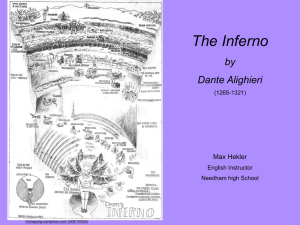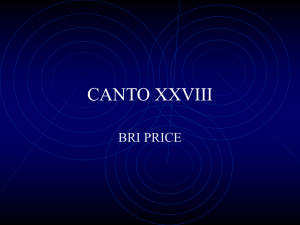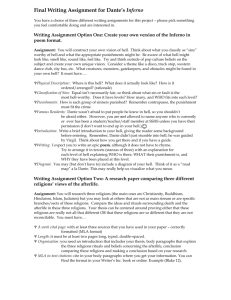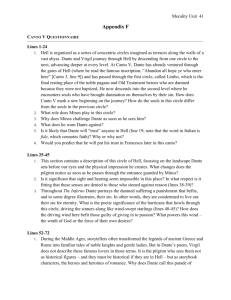Hell: An Introduction
advertisement
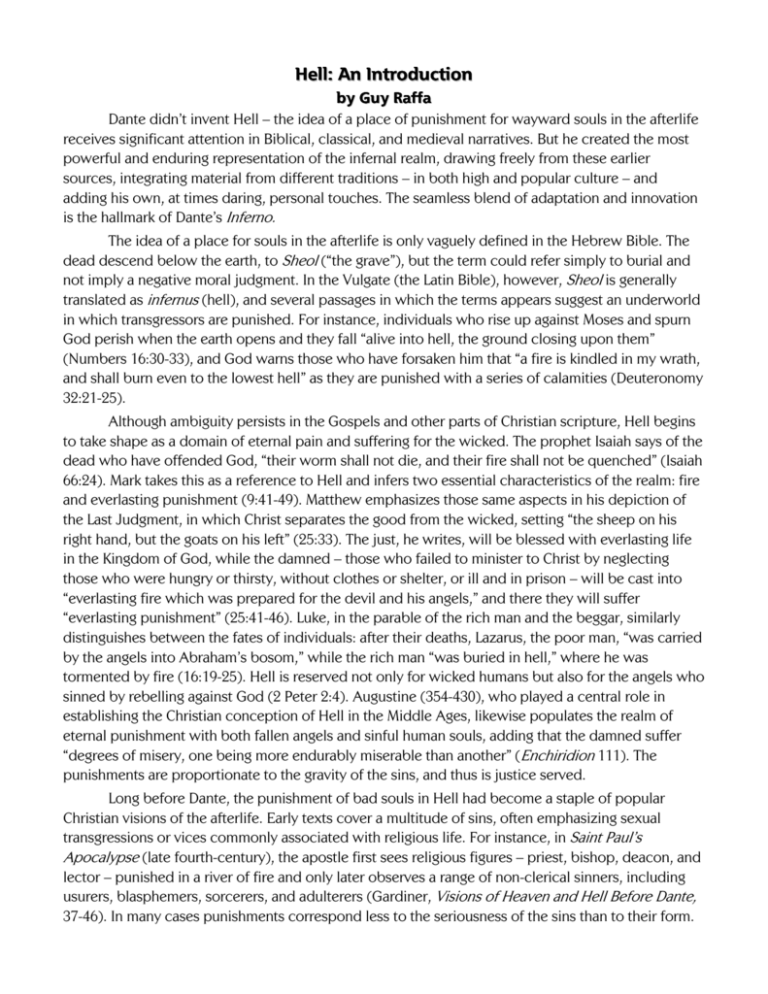
Hell: An Introduction by Guy Raffa Dante didn’t invent Hell – the idea of a place of punishment for wayward souls in the afterlife receives significant attention in Biblical, classical, and medieval narratives. But he created the most powerful and enduring representation of the infernal realm, drawing freely from these earlier sources, integrating material from different traditions – in both high and popular culture – and adding his own, at times daring, personal touches. The seamless blend of adaptation and innovation is the hallmark of Dante’s Inferno. The idea of a place for souls in the afterlife is only vaguely defined in the Hebrew Bible. The dead descend below the earth, to Sheol (“the grave”), but the term could refer simply to burial and not imply a negative moral judgment. In the Vulgate (the Latin Bible), however, Sheol is generally translated as infernus (hell), and several passages in which the terms appears suggest an underworld in which transgressors are punished. For instance, individuals who rise up against Moses and spurn God perish when the earth opens and they fall “alive into hell, the ground closing upon them” (Numbers 16:30-33), and God warns those who have forsaken him that “a fire is kindled in my wrath, and shall burn even to the lowest hell” as they are punished with a series of calamities (Deuteronomy 32:21-25). Although ambiguity persists in the Gospels and other parts of Christian scripture, Hell begins to take shape as a domain of eternal pain and suffering for the wicked. The prophet Isaiah says of the dead who have offended God, “their worm shall not die, and their fire shall not be quenched” (Isaiah 66:24). Mark takes this as a reference to Hell and infers two essential characteristics of the realm: fire and everlasting punishment (9:41-49). Matthew emphasizes those same aspects in his depiction of the Last Judgment, in which Christ separates the good from the wicked, setting “the sheep on his right hand, but the goats on his left” (25:33). The just, he writes, will be blessed with everlasting life in the Kingdom of God, while the damned – those who failed to minister to Christ by neglecting those who were hungry or thirsty, without clothes or shelter, or ill and in prison – will be cast into “everlasting fire which was prepared for the devil and his angels,” and there they will suffer “everlasting punishment” (25:41-46). Luke, in the parable of the rich man and the beggar, similarly distinguishes between the fates of individuals: after their deaths, Lazarus, the poor man, “was carried by the angels into Abraham’s bosom,” while the rich man “was buried in hell,” where he was tormented by fire (16:19-25). Hell is reserved not only for wicked humans but also for the angels who sinned by rebelling against God (2 Peter 2:4). Augustine (354-430), who played a central role in establishing the Christian conception of Hell in the Middle Ages, likewise populates the realm of eternal punishment with both fallen angels and sinful human souls, adding that the damned suffer “degrees of misery, one being more endurably miserable than another” (Enchiridion 111). The punishments are proportionate to the gravity of the sins, and thus is justice served. Long before Dante, the punishment of bad souls in Hell had become a staple of popular Christian visions of the afterlife. Early texts cover a multitude of sins, often emphasizing sexual transgressions or vices commonly associated with religious life. For instance, in Saint Paul’s Apocalypse (late fourth-century), the apostle first sees religious figures – priest, bishop, deacon, and lector – punished in a river of fire and only later observes a range of non-clerical sinners, including usurers, blasphemers, sorcerers, and adulterers (Gardiner, Visions of Heaven and Hell Before Dante, 37-46). In many cases punishments correspond less to the seriousness of the sins than to their form. Thus the narrator of Thurkill’s Vision (dated 1206) describes a vast arena in which the damned are tormented through reenactments of their offenses (Visions, 226-31), and the protagonist of Tundale’s Vision (1149), an Irish knight, witnesses God’s rendering of justice “to each one according to his or her merit”: thieves bear the weight of their loot while crossing a bridge of nails, and gluttons are butchered by executioners, while fornicators are impregnated by a beast (men as well as women!) and give birth to vipers (Visions, 155-71). Andreas Capellanus, in his highly influential The Art of Courtly Love (late twelfth-century), depicts the correspondence between human behavior and eternal consequences in an afterworld – divided into three concentric areas – based on how women treated men who sought their love (7483). The central location (called “Delightfulness”) is reserved for women who loved wisely, while the outermost region, assigned to women who rejected worthy suitors, resembles an earthly Hell. In this waterless region, called “Aridity,” women who spurned receive commensurate payment. Their bodies, dirty but still beautiful, are clad in filthy, heavy clothes. The ground, baked by the sun, scorches their bare feet. The women sit on bundles of sharp thorns, which are shaken by strong men and tear into their flesh. Such suffering “is scarcely to be found among the infernal powers themselves” (80). Suffering to a lesser degree, though still with no hope of relief, are those in the second region, “Humidity,” which is marked by frigid flooding waters, unbearable heat, and the absence of shade. These women, who shamelessly satisfied the lust of all suitors (worthy or not), are now swarmed by men seeking to serve them – so incessantly that no services can be rendered and the women would find it a comfort “if they had been left to serve themselves” (75). Dante puts the notion of poetic justice to even greater dramatic effect in the Inferno, devising appropriate torments for each particular sin. His representation of Hell far surpasses earlier versions both in its detailed examination of individual sinners’ lives and eternal punishments and in the precision and coherence of its overall moral structure. The foundation for the distribution and arrangement of sins in Dante’s Hell is the hierarchical scheme, derived from the Greek philosopher Aristotle (384-322 BCE), of incontinence, mad bestiality (“brutishness”), and malice. Onto these Aristotelian categories Dante grafts the seven deadly sins (at least in part) and a host of other offenses, creating a moral edifice capable of housing nearly every type of unrepentant sinner recognized in medieval Christian doctrine. Dante places the entrance to Hell at the center of the habitable northern hemisphere (where he locates Jerusalem). The structure of the underworld, as we learn during a pause in his descent (to allow him to adjust to the stench of lower Hell), consists mostly of concentric circles, widest at the top and narrowing as one approaches the earth’s core. Sins of incontinence or desire are punished in circles two through five, those whose sins involved violence occupy circle seven, and perpetrators of fraud are consigned to circles eight and nine. The first circle is Limbo – a region for those who, though virtuous, lacked Christian faith (or baptism) – and the sixth circle is reserved for heretics. To flesh out the topography of Hell and the creatures charged with judging, transporting, guarding, and tormenting the shades of the damned, Dante transforms and systematizes material from representations of the classical underworld (Hades). He engages most extensively with the Roman writer Virgil (70-19 BCE), who recounted Aeneas’s visit to the lands of the dead – at once terrifying, heartbreaking, and edifying – in book 6 of the Aeneid. While Virgil imbued his underworld with a fluid, dreamlike atmosphere, Dante strives for greater realism, providing features that are more sharply drawn and tangible. Four classical rivers (Acheron, Styx, Phlegethon, Cocytus), whose purposes and courses appear to overlap in Virgil’s Aeneid, serve distinct functions within an elaborate water system in Dante’s Inferno. Likewise, Dante recasts an impressive array of Virgilian creatures to fill roles both practical and symbolic within his medieval Christian Hell: Charon, Minos, Cerberus, Plutus, Phlegyas, Furies, the Minotaur, Centaurs, Harpies, Geryon, and several Giants are among the figures appearing in both works. It is no wonder than Dante chooses Virgil himself as his guide through the infernal realm and – to increase the poignancy of Virgil’s status as a beloved authority in the Christian afterlife – through Purgatory as well. Dante skillfully molds these disparate elements into a world at once unified and varied – and frighteningly believable. But his depiction of Hell is also remarkable for several outright inventions. While Limbo, for instance, was accepted in late medieval Christian theology as the place for unbaptized children in the afterlife, Dante expands its population to include virtuous individuals who lived before Christianity, as well as other select non-Christians. He also creates an extraordinary rule for one group of sinners: traitors against guests lose their souls to Hell not at death but at the moment of their betrayal, and demons inhabit their bodies for the rest of their mortal lives. The poet’s most important conceptual innovation, however, may be his discovery of a region just outside the nine infernal circles in which throngs of cowardly souls and neutral angels – scorned by Heaven and Hell alike – are punished for having refused to take a stand between good and evil. For seven centuries, Dante’s Hell has elicited strong reactions – from fascination to revulsion and everything in between. Whatever responses the Inferno evokes in today’s and tomorrow’s readers, they are unlikely to be neutral.

